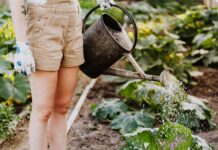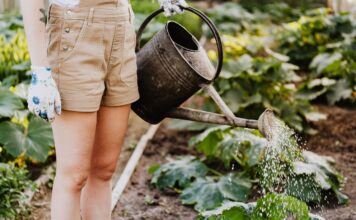Discover the world of organic gardening with this comprehensive guide that will take you through everything from understanding the definition and principles of organic gardening to planning, preparing, and maintaining your very own organic garden. Learn about the benefits of embracing organic techniques, the differences between organic and conventional gardening, and how to select the right plants for your garden. Dive into topics such as soil preparation, organic fertilization, pest management, disease control, and water conservation to help you create a thriving, sustainable garden. And for those with limited space, we cover organic gardening in containers as well. Get ready to embark on a journey towards a healthier, more environmentally friendly garden.
Understanding Organic Gardening
Definition and Principles of Organic Gardening
Organic gardening is a holistic approach to cultivating plants that focuses on enhancing the health of the entire ecosystem, including the soil, plants, and various organisms within it. The primary goal of organic gardening is to build productive and sustainable garden ecosystems through renewable and chemical-free resources. By avoiding synthetic fertilizers, pesticides, and genetically modified organisms, organic gardeners aim to develop a biologically diverse and balanced environment that encourages the growth of healthy, vigorous plants.
The principles of organic gardening are rooted in the following concepts:
- Soil Health: Organic gardeners believe that healthy soil is essential for healthy plants. By fostering a nutrient-rich, well-aerated, and biologically active soil system, plants can achieve optimal growth, productivity, and disease resistance. Organic gardeners use practices like composting, cover cropping, and organic amendments to enrich the soil naturally.
- Biodiversity: Organic gardens embrace a diverse array of plants, animals, and microorganisms as a way to maintain ecological balance and promote natural pest control. Biodiversity not only leads to more interesting gardens but also creates a resilient ecosystem that can withstand pests, diseases, and other challenges.
- Pest and Disease Management: Organic gardeners focus on prevention rather than relying on chemical treatments to manage pests and diseases. By encouraging a diverse array of beneficial organisms like predatory insects, good bacteria, and fungi, organic gardens can control pests and diseases naturally. Gardeners also practice cultural controls, such as crop rotation and selecting disease-resistant plant varieties.
- Water Conservation: Water is a precious resource, and organic gardeners focus on using it wisely. Techniques like mulching, drip irrigation, and planting drought-tolerant species help conserve water and reduce the need for supplementary irrigation.
- Recycling and Reusing: Organic gardeners aim to reduce waste and conserve resources by recycling and reusing materials whenever possible. This includes practices like composting, using reclaimed materials, and repurposing items to minimize the environmental impact and overall cost of gardening.
Benefits of Organic Gardening
Organic gardening has several advantages over conventional gardening, which includes the following:
- Improved Soil Health: Organic gardening techniques help improve the structure, fertility, and biological activity of the soil, resulting in healthier and more productive plants.
- Reduced Chemical Exposure: By avoiding synthetic pesticides and fertilizers, organic gardening reduces the risk of contaminating the environment and human exposure to potentially harmful chemicals.
- Biodiversity and Ecosystem Services: Organic gardens support a higher level of biodiversity, which contributes to pollination, natural pest control, and improved soil fertility.
- Food Safety and Nutrition: Organic gardening can produce nutrient-dense fruits and vegetables free from synthetic pesticide residues, potentially increasing the quality and safety of the food supply.
- Climate Change Mitigation: Organic gardening practices help in carbon sequestration, reducing greenhouse gas emissions, and promoting greater overall sustainability.
- Aesthetic and Therapeutic Benefits: Organic gardens can provide beautiful, serene environments that promote relaxation, stress reduction, and overall well-being.
Differences Between Organic and Conventional Gardening
Although organic and conventional gardening may share similarities, there are significant differences between the two approaches, which include the following:
- Input Materials: In organic gardening, synthetic pesticides, fertilizers, and genetically modified organisms are not used. Instead, gardeners use natural and renewable resources, such as compost, manure, and other organic amendments for improving soil fertility.
- Pest and Disease Management: While conventional gardeners may rely primarily on synthetic chemicals for pest and disease control, organic gardeners employ preventive and natural methods, such as promoting biodiversity, utilizing beneficial insects, and practicing proper sanitation and cultural controls.
- Soil Health and Fertility: Organic gardeners place strong emphasis on building soil health and fertility through the use of organic matter, cover crops, and other strategies. Conventional gardening may prioritize quick fertilization using synthetic products, sometimes neglecting long-term soil health.
- Biodiversity: Organic gardens typically support a higher level of biodiversity and encourage the proliferation of beneficial organisms, which help maintain natural ecological balance.
- Environmental Impact: Organic gardening practices aim to minimize negative environmental impacts by avoiding synthetic inputs, conserving water, and promoting ecological sustainability. Conventional gardening, on the other hand, might contribute to environmental pollution and resource depletion through the use of chemicals and other non-renewable inputs.
In summary, organic gardening is a holistic approach to plant cultivation, focusing on nurturing the entire ecosystem rather than only addressing specific issues. Embracing biodiversity, soil health, and sustainable practices, organic gardening provides various benefits, including improved environmental health, food quality, and overall ecosystem resilience. By understanding the differences between organic and conventional gardening, individuals can make informed choices about adopting practices that align with their values and goals.
Planning Your Organic Garden
The success of an organic garden lies in proper planning and preparation. Designing your garden for optimal growth requires forethought and consideration of factors like location, size, and planting schedules. Follow this comprehensive guide to get started on preparing your organic garden efficiently.
Selecting the Right Location
One of the most vital aspects of planning your organic garden is selecting the right location, which is crucial to your plants’ health and productivity. Consider the following factors before finalizing the site for your garden.
- Sunlight: Most vegetables and fruits require a minimum of 6-8 hours of direct sunlight daily. Choose an area that receives ample sun, keeping in mind that the sun’s position changes throughout the seasons. If sunlight is an issue in your area, consider planting sun-loving plants in containers that can be moved around.
- Soil: Testing your soil is essential to understanding its composition and to determine what improvements are required to create an ideal growing environment for plants. You can purchase soil test kits or send a sample to a local extension for analysis. Based on the test results, you can adjust your soil’s pH, add organic matter or use specific organic fertilizers to meet your plants’ needs.
- Drainage: Good drainage is essential for a successful organic garden, as waterlogged soil can disrupt roots and encourage the growth of diseases. Avoid any areas where water tends to pool when it rains or near downspouts, and consider building raised beds to improve drainage.
- Accessibility: Plant your garden in an area easily accessible for watering, maintenance, and harvesting. Ideally, your garden should be near a water source and easily visible from your home to monitor potential issues like pests.
Choosing Appropriate Garden Size and Layout
Determining the appropriate garden size and layout primarily depends on the space available and types of plants you wish to grow.
Establish the scale of your garden by considering the number of plants you want to grow and their spacing requirements. Larger plants require more room, while smaller plants can take up less space. Keep walkways and access routes in mind when planning your layout.
Raised beds are a popular choice in organic gardening because they provide better soil control and improved drainage. Creating paths between beds ensures easy access to plants and reduces soil compaction.
Vertical gardening is a space-saving option that allows you to grow more plants in a smaller area. This method involves utilizing a variety of structures, such as trellises, cages, and netting, to support and train plants upwards, effectively increasing yield per square foot.
It’s essential to practice crop rotation in your garden design, meaning you alternate the plant families grown in specific beds each season. This practice prevents the build-up of pests and diseases and helps maintain soil fertility.
Creating a Planting Calendar
A well-planned planting calendar is instrumental in ensuring a productive organic garden. A planting calendar can help you work out which plants to grow when and when to start seeds indoors or outdoors.
Begin by researching the average frost dates for your region, which will dictate your planting schedule. Consult your local extension office for this information or search online resources.
Next, identify the ideal planting times for the specific crops you plan to grow. Be aware of seasonal temperature requirements and the germination and maturation times of each plant.
When creating your calendar, pay attention to the following aspects:
- Seed starting dates: Determine the appropriate time to start seeds indoors or directly sow them into the garden. Starting seeds too early or too late can result in weak or unproductive plants.
- Planting dates: Indicate when to transplant seedlings outdoors or when to sow seeds directly into the garden.
- Harvest dates: Keep track of expected harvest times to know when your efforts will yield fresh produce and help you plan for potential succession planting, meaning growing a series of the same or different plants in the same space over multiple seasons.
By considering these factors while planning your organic garden, you’ll be well on your way to reaping the rewards of a flourishing and sustainable garden. Consult further resources and gardening literature to fine-tune your plan to suit your specific region and growing conditions.
Preparing Your Organic Garden Soil
One of the critical factors in the success of an organic garden is the quality of the garden soil. Healthy soil provides the necessary nutrients and support for growing plants, ensuring a bountiful and productive harvest. To adequately prepare your organic garden soil, you must carry out a few critical tasks – testing and amending the soil, understanding the importance of soil structure and drainage, and using organic matter and compost.
Testing and Amending the Soil
Before preparing the soil for planting, it is essential to test its pH and nutrient levels. The pH measurement indicates how acidic or alkaline the soil is on a scale from 1 to 14, with 7 being neutral. Most plants thrive in soils with a pH between 6 and 7.5, which allows essential nutrients to be readily absorbed by plant roots. You can purchase a soil test kit from a gardening store or online, and it is simple to conduct the test yourself.
Once you know the pH level of your soil, you can amend it accordingly. If the soil is too acidic (pH below 6), applying limestone or wood ashes will raise the pH. Conversely, if the soil is too alkaline (pH above 7.5), using sulfur or soil acidifiers will lower the pH. Note that individual plants vary, and some may require slightly different pH levels.
Testing the nutrient levels will reveal if your soil is lacking any essential nutrients or if any nutrients are in excess. Nitrogen, phosphorus, and potassium are the primary nutrients needed for optimal plant growth. Depending on the nutrient levels, you may need to add organic matter or other organic supplements such as compost or well-aged manure to balance the levels.
Importance of Soil Structure and Drainage
Soil structure refers to the arrangement of soil particles and the spaces between them. Healthy soil structure promotes air circulation, water drainage, and root penetration. There are three main types of soil textures based on particle size: sandy, loamy, and clay.
Sandy soils are coarse and drain water quickly, often resulting in nutrient leaching. Clay soils, on the other hand, compact easily and can become waterlogged, which restricts root growth and oxygen flow within the soil. Loamy soils are ideal, as they offer a good balance of drainage, nutrient retention, and aeration.
To improve soil structure, it is essential to add organic matter such as compost, leaf mold, or well-rotted manure. These organic materials will improve the drainage of clay soils, increase the water and nutrient retention of sandy soils, and generally promote better air circulation and root penetration.
Furthermore, avoid walking on planting beds to prevent soil compaction, which may negatively affect drainage and aeration. It’s also essential to practice crop rotation to prevent nutrient depletion and maintain soil structure.
Using Organic Matter and Compost
Adding organic matter to your garden soil is an essential part of the organic gardening process. Organic materials like compost, leaf mold, or aged manure can significantly enrich the soil, providing all the necessary nutrients and improving the soil structure.
Compost is decomposed organic material, and it plays a crucial role in promoting microbial life in the soil. Microorganisms help break down the organic matter further, making nutrients more accessible to plant roots. Additionally, composting is an excellent way to recycle food scraps and yard waste, reducing your contribution to landfills.
To create your compost pile, alternate layers of greens (vegetable scraps, grass clippings, or green leaves) and browns (dried leaves, small branches, or straw). Make sure to turn the pile periodically to aerate it and speed up the decomposition process. Once the compost is ready (usually around three to six months), it can be applied directly to the garden beds or mixed with soil before planting. Compost can be added to the soil in spring to add nutrients and improve soil structure before planting and also in fall to help condition the soil for the next growing season.
In conclusion, preparing your organic garden soil is crucial to establish healthy plants and ensure a successful harvest. By testing the soil, amending it accordingly, and fostering a thriving environment for your crops, you’ll create a foundation that supports a robust and productive organic garden.
Plant Selection for Organic Gardening
Organic gardening is a method of growing plants without the use of synthetic fertilizers, pesticides, or genetically modified organisms (GMOs). The key to a successful organic garden lies in choosing the right plants. Plant selection is essential for creating a healthy and thriving organic garden. It involves choosing plant varieties that are suited to the local climate, soil conditions, and other environmental factors, as well as selecting plants that have been adapted for organic cultivation. There are three main aspects to consider when choosing plants for your organic garden: suitable plant varieties, native and heirloom species, and companion planting.
Choosing Suitable Plant Varieties
Selecting suitable plant varieties is essential for organic gardening since some plants are more resistant to pests, diseases, and weather conditions than others. When choosing plants for your organic garden, consider the following factors:
- Seasonal climate: Understand the climate in your area and choose plants that grow well in your specific conditions. Choose annual plants that can complete their life cycle during the growing season in your area, and avoid planting perennials that require a longer growing season than what you have.
- Soil type: Determine the type of soil in your garden, and then choose plants that can thrive in those specific conditions. For example, if you have sandy soil, choose plants with deep root systems that can adapt to drier conditions.
- Pest and disease resistance: Look for plant varieties that are resistant to common pests and diseases in your area. This will reduce the need for chemical pesticides and make it easier for beneficial insects to thrive in your garden.
- Pollinator attraction: Choose plants that attract pollinators, such as bees, butterflies, and hummingbirds. This will not only benefit the plants in your garden but also promote a healthier ecosystem.
- Drought tolerance: In water-scarce regions or during drought periods, choose plants that can tolerate low-water conditions.
Planting Native and Heirloom Species
Native plants are those that have naturally grown in a specific region without human intervention. They have adapted to the local climate, soil, and wildlife, making them a perfect choice for organic gardens. Some benefits of native plants include:
- Low maintenance: They can survive and thrive with little to no human intervention, as they are adapted to the local conditions.
- Pest resistance: Native plants have evolved over time to resist pests and diseases found in their natural habitat.
- Support for biodiversity: Planting native species helps to maintain the integrity of local ecosystems and encourages biodiversity by providing food and shelter for native wildlife.
Heirloom species are non-GMO, non-hybrid plant varieties that have been passed down through generations. Choosing heirloom plants ensures that you are growing purebred plants without any human intervention in the form of genetic manipulation. Heirloom plants typically have superior taste, nutrition, and hardiness compared to hybrid or GMO varieties.
Understanding Companion Planting
Companion planting is a technique used in organic gardening where different plants are grown together to promote mutual benefits such as pest control, pollination, and improved soil health. Some examples of companion planting include:
- Pest control: Planting strong-scented herbs like basil and rosemary near vegetable plants can help repel pests like aphids and beetles.
- Soil improvement: Legumes, such as beans and peas, can help improve soil fertility by fixing nitrogen from the air into the soil. Planting these alongside nitrogen-hungry plants like corn or squash can provide a natural source of nitrogen for the plants.
- Pollination: Planting flowers that attract pollinators like bees and butterflies can help to improve the pollination of your fruit and vegetable plants, resulting in larger harvests.
When planning your organic garden, it is essential to research the potential relationships between different plants and choose combinations that will support the overall health and productivity of your garden. Overall, selecting the right plants for your organic garden can be a fun and rewarding experience that leads to a thriving, productive, and environmentally friendly garden.
Organic Fertilization and Soil Amendments
Organic fertilization and soil amendments are essential for maintaining a healthy garden or crop-filled landscape. Organic fertilizers add vital nutrients to the soil, while soil amendments make the necessary changes to improve or stabilize your soil for a successful, sustainable planting environment. Both of these options are eco-friendly and chemical-free, making them a smart choice for anyone looking to boost their garden’s health naturally. In this article, we will discuss the types of organic fertilizers, how to apply them, and how to use soil amendments to improve soil conditions.
Types of Organic Fertilizers
Organic fertilizers are made from natural materials, including animal and plant matter, and minerals. As these materials break down, they slowly release essential nutrients into the soil that help plants grow strong and healthy. There are several types of organic fertilizers, including:
- Animal-based fertilizers: These types of fertilizers are made from animal waste, such as manure, bone meal, and fish meal. Animal-based fertilizers are rich in nitrogen, phosphorus, and potassium, which are essential nutrients for plant growth. Manure is a popular choice for many gardeners, as it’s loaded with nutrients like nitrogen, phosphorous, and potassium that help plants grow. Eggshells, fish emulsion, and blood meal are other options that come from animal byproducts.
- Plant-based fertilizers: Plant-based fertilizers are derived from organic plant materials, such as compost, alfalfa meal, and soybean meal. Compost is a top choice among organic gardeners because it adds valuable nutrients back into the soil and improves its overall structure, providing plants with a nutrient-rich environment to grow in. Other plant-based options include seaweed, green manure, and cover crops that help enrich and protect the soil.
- Mineral-based fertilizers: These fertilizers are made from natural mineral deposits, including limestone, rock phosphate, and greensand. Mineral-based fertilizers can help correct specific nutrient deficiencies in the soil, such as calcium, magnesium, or potassium. Greensand, for example, helps improve potassium levels in the soil while also helping to loosen clay soil and improve water retention in sandy soil.
Applying Organic Fertilizers Correctly
To apply organic fertilizers correctly and efficiently, follow these steps:
- Determine the correct type and amount of fertilizer needed: Evaluate your soil to know what nutrients it lacks and choose the appropriate organic fertilizer to provide those necessary nutrients.
- Follow the recommended application rate: Carefully read the package instructions for the specific organic fertilizer you have chosen to ensure proper application and avoid over-fertilization.
- Apply fertilizer evenly: Scatter the fertilizer in an even layer over the soil surface or incorporate it into the top inch of soil. This helps ensure that nutrients are dispersed consistently and prevents nutrient hotspots that could harm plants.
- Water the area well: After applying the organic fertilizer, water the area well to facilitate the movement of nutrients into the soil and stimulate the breakdown of the fertilizer.
- Monitor the growth and condition of your plants: Keep an eye on your garden to determine if the organic fertilizer application has been effective. Look for signs of improved plant health, such as increased growth, more flowers and fruit, and healthier foliage.
Using Soil Amendments to Improve Soil Conditions
Soil amendments are added to the soil to improve its physical properties, including drainage, water retention, aeration, and overall structure. Here are some organic soil amendments that you can use to improve your soil’s condition:
- Compost: Adding compost is an excellent way to improve the overall structure and fertility of your soil. Compost introduces valuable organic matter and beneficial microorganisms, which helps enhance soil nutrients, water capacity, aeration, and drainage.
- Peat moss: Peat moss is a great amendment for sandy or clay soil, as it helps improve water retention and aeration. It can also help balance soil pH.
- Aged manure: Like compost, aged manure adds valuable organic matter to the soil and helps improve its overall structure and fertility.
- Coconut coir: Made from the husks of coconuts, coconut coir is an eco-friendly alternative to peat moss that improves soil structure and moisture retention.
- Gypsum: Gypsum is a mineral-based amendment that can help break up heavy clay soils and improve their drainage.
Remember always to conduct a soil test before adding amendments to ensure you make the correct adjustments to your soil. This will help you create a healthier planting environment for your garden or crop-filled landscape.
Pest Management in Organic Gardening
Organic gardening is an environmentally friendly way to produce food and maintain a green space. One of the main challenges faced by organic gardeners is pesky insects and other creatures that damage plants, vegetables, and fruits. Many people turn to chemicals and synthetic pesticides to keep these pests at bay, but organic gardeners have a different set of tools in their arsenal. In this article, we will discuss common garden pests and organic methods for managing them, including the strategic use of beneficial insects and wildlife.
Identifying Common Garden Pests
The first step in managing pests in an organic garden is learning to identify the culprits. There are many different pests that can attack your plants, but a handful of them are particularly dangerous and should be monitored and controlled carefully. Some common garden pests include:
- Aphids: These small, soft-bodied insects can quickly damage plants as they suck the sap from leaves, stems, and flowers. Aphids can cause yellowing, curling, and distortion of leaves, as well as stunted growth and reduced yields. They also secrete a sticky substance called honeydew that can attract ants, mold, and other issues.
- Caterpillars: Various types of caterpillars, such as tomato hornworms or cabbage loopers, can cause significant damage as they chew on leaves, stems, and fruits. They can be difficult to spot as many types camouflage well on the plants they are feeding on.
- Slugs and Snails: These slimy pests consume tender plant tissue, often leaving ragged holes in leaves. They can be particularly troublesome in damp or humid environments.
- Cutworms: These moth larvae feed on plant stem bases, often causing young plants to topple over and die.
- Colorado Potato Beetles: As the name suggests, these beetles are a major problem for potato growers, but they can also attack other plants, like tomatoes and eggplants.
Once you’ve identified the pests affecting your garden, you can choose appropriate organic control methods.
Employing Organic Pest Control Methods
There are a variety of organic methods that can be used to manage pests in the garden, depending on the specific needs and circumstances:
- Barriers, Traps, and Repellents: Gardeners can create physical and biological barriers, like copper tape or diatomaceous earth, to deter pests from accessing plants. Sticky traps, beer traps, and pheromone traps can also help manage some pests. There are also organic repellents, like neem oil or garlic, that can be used to dissuade pests from attacking plants.
- Biological Control: Using predators, parasites, and pathogens to control pests is an important part of organic gardening. Introducing beneficial insects like ladybugs or praying mantises to the garden can help control aphids and other pests.
- Cultural Practices: Proper garden maintenance, such as regular pruning, removing dead plant material, rotating crops, using resistant varieties, and practicing intercropping, can help prevent pest problems and promote plant health.
- Manual Control: Hand-picking pests, like caterpillars or beetles, from plants can be a simple but effective way to control populations. Additionally, using a strong stream of water to knock off aphids and mites can also be helpful.
Attracting Beneficial Insects and Wildlife
Creating a diverse and welcoming habitat for beneficial insects and wildlife is an important element of organic pest management. Many creatures, like birds, toads, and ground beetles, help to control harmful pests by consuming them. One key strategy for attracting beneficial wildlife is to plant a diverse array of flowers and native plant species that provide shelter, food, and breeding sites.
Some methods for attracting beneficial insects include:
- Building an insect hotel or providing small brush piles to offer shelter for insects like ladybugs, lacewings, and ground beetles.
- Creating a bee-friendly garden by planting a variety of flowering plants, such as lavender, yarrow, and borage, that bloom throughout the season.
- Planting a variety of native shrubs and trees that provide food and shelter for birds and other wildlife.
- Providing water sources like birdbaths or ponds to ensure wildlife has a place to drink and cool down in hot weather.
Incorporating these practices and strategies in your organic garden will help you manage pests in an environmentally friendly and sustainable way. By working in harmony with nature, you can help protect the environment and create a healthier, more productive garden.
Organic Disease Control and Prevention
As gardeners and farmers, one of our primary concerns in maintaining healthy plants is managing and preventing diseases. Diseases can significantly impact crop yields and can be challenging since they often spread quickly. Organic disease control involves non-chemical methods to control plant diseases and keep your plants healthy. This approach emphasizes prevention and management through cultural and biological practices, without relying on synthetic chemicals. In this article, we’ll discuss understanding common plant diseases, implementing organic disease control methods, and practices for preventing diseases in the garden.
Understanding Common Plant Diseases
Different types of plant diseases can affect your crops, and they can be caused by fungi, bacteria, or viruses. It’s crucial to identify these diseases to develop proper control strategies.
- Fungal diseases: These are the most common diseases affecting plants, and they thrive in moist conditions. Common fungal diseases include powdery mildew, downy mildew, rust, and various types of blights affecting leaves, stems, or fruits.
- Bacterial diseases: Bacterial diseases often enter plants through wounds caused by insects, tools or weather conditions. They may cause diseases such as bacterial leaf spots, cankers, and soft rots. Bacterial diseases typically spread more slowly than fungal diseases but can be challenging to control.
- Viral diseases: Viruses affect plants through mechanisms such as sap-sucking insects, infected propagation materials or contact between diseased and healthy plants. Common viral diseases include mosaic, leaf curl, and yellowing diseases.
Understanding the pathogens causing these diseases helps in selecting the most appropriate organic control strategies.
Implementing Organic Disease Control Methods
Organic disease control typically involves a combination of cultural, biological, and physical methods. These methods help maintain healthy plants and environments less susceptible to disease.
- Cultural methods: These involve managing the growing environment to reduce disease pressure. Examples of cultural methods include crop rotation, choosing disease-resistant plant varieties, proper spacing, and irrigation to minimize moisture on plant surfaces.
- Biological methods: These methods involve the use of beneficial organisms or living organisms, such as bacteria and fungi, to control disease pathogens. For example, incorporating beneficial soil microorganisms like Trichoderma spp. or Bacillus spp. can help suppress soil-borne diseases. Also, implementing practices such as encouraging natural predators can reduce the risk of diseases spread by insects.
- Physical methods: These methods directly remove or reduce the presence of pathogens. Examples include pruning of infected plant parts to prevent diseases from spreading, and solarization, a technique using the sun’s energy to heat the soil and kill pathogens.
Practices for Preventing Diseases in the Garden
Preventing diseases from developing or spreading is key to maintaining a healthy and productive garden. By implementing good gardening practices, we can significantly reduce the risk of diseases.
- Start with healthy plants: Invest in disease-free, certified seeds or seedlings. Healthy plants have a better chance of resisting diseases.
- Use organic amendments: Compost, well-aged manure, and other organic matter can improve soil structure and introduce beneficial microorganisms, reducing the risk of pathogens.
- Practice good garden hygiene: Remove diseased plant material from the garden and dispose of it carefully. Regularly sanitize your gardening tools and equipment to prevent the spread of diseases.
- Encourage beneficial insects: Create a welcoming environment for natural predators and pollinators by planting a diverse range of flowering plants.
- Monitor your plants: Pay attention to the appearance and health of your plants. Early detection and intervention can help stop the spread of diseases.
Organic disease control and prevention forms an essential component of sustainable agriculture and horticulture. By understanding common plant diseases, implementing proper control methods, and practicing prevention techniques, we can create healthy and productive gardens without the use of harmful chemicals.
Water Conservation and Irrigation in Organic Gardening
Organic gardening can provide several benefits, such as the promotion of biodiversity, the reduction of chemical pollution, and the provision of healthy food. However, water conservation is essential not only to ensure the sustainability of these benefits but also to fulfill increasing needs amidst climate change and population growth. In this context, water conservation and irrigation practices in organic gardening can help maintain the soil’s natural state, improve plant health, and reduce environmental impacts. In this article, we will discuss water-saving techniques, choosing the right irrigation system, and proper watering practices for healthy plants.
Water-Saving Techniques
There are several ways to conserve water in organic gardens. By employing these water-saving techniques, gardeners can reduce the amount of water needed and also improve the overall health of the garden.
- Mulching: Applying a layer of organic material, such as straw or wood chips, to the soil surface can help retain moisture and reduce evaporation. Mulch also helps to moderate soil temperature, prevents soil erosion, and adds nutrients to the soil as it decomposes over time. Aim for a 2-4 inch layer of mulch around plants to maximize water retention.
- Plant Selection: Choose plants that are native to your area or varieties that are adapted to the local climate. These plants are more likely to thrive with less water and could be more resistant to pests and diseases. In addition, consider using drought-tolerant plants, which require less water than other plants.
- Efficient Garden Layout: Grouping plants with similar water needs together can save water since each group can be watered according to its specific requirements. Additionally, creating raised beds and planting in rows can help minimize runoff and maximize water absorption.
- Maintain Healthy Soil: Healthy soil allows for better water infiltration, root development, and nutrient retention. Incorporate organic compost and use cover crops to improve soil structure and fertility.
- Rainwater Collection: Collect and store rainwater in barrels, cisterns, or ponds to be used for irrigation later. This reduces the need for using tap or well water and helps conserve valuable water resources.
Choosing the Right Irrigation System
Efficient watering depends on the choice of an appropriate irrigation system, which needs to be tailored according to the size, shape, and requirements of the garden. Some irrigation options to choose from include:
- Drip Irrigation: This system uses a network of pipes and drippers to deliver water directly to the base of each plant. It conserves water by minimizing evaporation and runoff and is well-suited to water-sensitive plants, such as tomatoes and peppers.
- Soaker Hoses: Made of porous materials, these hoses release water slowly along their length when water pressure is applied. This is a useful method for raised beds, long rows, and narrow gardens. However, soaker hoses should be placed under mulch to prevent evaporation.
- Sprinklers: Although efficient for watering large areas, sprinklers tend to waste more water due to evaporation and runoff. If you choose sprinklers, consider those with low application rates or a pulsating action to deliver water in droplets rather than a fine mist.
- Hand Watering: This method provides control over water application, but it requires time and effort. Use a watering can or a hose with a shutoff nozzle to ensure water is applied directly to the plant’s base and not wasted on pathways or empty areas.
Proper Watering Practices for Healthy Plants
Proper watering goes beyond the choice of an irrigation system; knowing when and how much to water is crucial to help plants develop strong root systems and resist diseases.
- Watering Frequency: How often you water will depend on factors like soil type, weather, and plant growth stage. In general, it is better to water deeply and less frequently than shallow and often. This encourages deep root growth, making plants more resilient in periods of drought.
- Watering Time: The best time to water is in the early morning or late afternoon when evaporative loss is minimal, and the water will not be wasted. Avoid watering during the heat of the day or windy conditions, where water loss due to evaporation is significantly higher.
- Monitoring Soil Moisture: Use a soil moisture meter or the finger test (poke a finger into the soil about 2 inches deep) to check if the soil is dry and needs watering. Regularly monitoring moisture levels can help determine when and how much to water.
- Avoid Overwatering: Excessive water can suffocate plant roots, cause root rot, and increase the susceptibility of plants to diseases. Ensure good drainage and do not let plants sit in standing water.
By implementing these water conservation techniques, choosing the right irrigation system, and practicing proper watering methods, you can create a healthy and sustainable organic garden while contributing to environmental conservation.
Maintaining and Harvesting Your Organic Garden
Organic gardening requires a keen eye and a dedication to nurturing plants naturally. One of the most important aspects of maintaining and harvesting your organic garden is the process of caring for the plants themselves. This includes pruning and thinning, using mulch to control weeds and retain soil moisture, and ensuring that when it is time to harvest, you do so in the most sustainable way possible. In this article, we will outline the key steps to maintaining and harvesting a thriving organic garden.
Proper Pruning and Thinning Techniques
Pruning and thinning out your plants is essential for promoting the healthy growth of your garden. The benefits of this process include improved air circulation, better light penetration, more vigorous growth, and higher yields. However, it is important to know the proper techniques for pruning and thinning to minimize stress and potential damage to your plants.
To begin the pruning process, start by removing dead, damaged, or diseased branches or stems. Sterilize your pruning tools between cuts to prevent the spread of disease. Next, identify any branches that are crossing or rubbing against each other, and remove the weaker one to prevent future issues. It’s also important to create an open and balanced structure by removing branches that crowd the center of the plant.
When thinning plants, it’s important to do so at the right time in the plant’s growth cycle. Thinning is generally done for plants that are grown from seed and have germinated in close proximity to one another. This process allows the remaining plants to have more space to develop stronger root systems and grow. To properly thin your plants, follow these steps: 1. Wait until seedlings have developed at least two sets of true leaves. 2. Determine the final desired spacing between plants based on their mature size. 3. Gently remove seedlings, leaving the healthiest-looking plants intact. 4. Dispose of the removed seedlings or transplant them to another location if desired.
Using Mulch to Control Weeds and Retain Soil Moisture
Mulching is a simple yet highly effective practice for maintaining an organic garden. Mulches can be made from organic materials such as straw, hay, leaves, grass clippings, and compost. By applying a thick layer of mulch to the surface of your garden soil, you can prevent weed growth and retain moisture, reducing the need for watering. Less weed competition means your plants can concentrate on growing and producing delicious fruits and vegetables.
When applying mulch to your organic garden, follow these steps: 1. Prepare the soil by weeding and watering the area. 2. Apply a 2-4 inch layer of mulch evenly across the soil surface, keeping the mulch a few inches away from the base of your plants to prevent rot and pest issues. 3. Replenish the mulch layer as needed throughout the growing season to maintain an effective weed and moisture barrier.
Harvesting Your Organic Produce
When it’s time to enjoy the fruits of your labor, it’s important to have a plan in place for harvesting your organic produce. Harvesting your crops at the right time is key to maximizing their flavor and quality.
Some general tips for harvesting organic produce include: 1. Harvest produce early in the morning, when temperatures are cooler and plants are well-hydrated. 2. Use clean, sharp tools to cut produce from the plants to prevent damage and contamination. 3. Regularly harvest ripe produce to encourage continued production and prevent over-ripening or rot.
Each type of fruit or vegetable may require different harvesting methods and timelines. For example, leafy greens should be harvested when they are young and tender, while root vegetables can be left in the ground until they reach their full maturity. It’s essential to educate yourself about the specific harvesting requirements of each plant in your organic garden to ensure the best quality and flavor for your family to enjoy.
Organic Gardening in Containers and Small Spaces
Organic gardening in containers and small spaces is an excellent way to enjoy fresh, homegrown vegetables, herbs, and flowers regardless of limitations such as limited yard space, mobility issues, or urban living conditions. Growing plants in containers allows for greater control over soil quality, watering, and pest management, making it an ideal method for organic gardening. This article will cover selecting containers, soil preparation and fertilization, and choosing plants for a successful organic container garden.
Selecting Suitable Containers for Organic Gardening
When choosing containers for organic gardening, it is crucial to consider the size, material, and drainage of the container. Here are a few factors to consider when selecting a container:
1. Size: The size of the container should be appropriate for the plant’s mature size, allowing for sufficient root development. A container that is too small may lead to stunted growth and poor yields, whereas an excessively large container may result in wasted soil and resources. As a rule of thumb, annual vegetables should have at least 12 inches of soil depth, and perennial plants should have 18 inches of soil depth.
2. Material: Organic gardening containers can be made from a variety of materials, including terra-cotta, plastic, wood, and fabric. Terra-cotta pots are porous and allow for good air circulation but can become unstable and crack in extreme temperatures. Plastic pots are lightweight and inexpensive, but may not be as eco-friendly as other materials. Wooden containers are durable and provide a natural look, but may decompose over time. Fabric containers, such as grow bags, provide excellent drainage and air circulation, and can be easily stored when not in use.
3. Drainage: Adequate drainage is essential to prevent root rot and other diseases. Ensure that your chosen container has drainage holes at the bottom to allow excess water to escape. If your container does not have pre-existing holes, you can drill some yourself or place a layer of pebbles or broken pottery at the bottom to facilitate drainage.
Container Soil Preparation and Fertilization
For healthy, productive organic container gardens, it is essential to use a suitable soil mix and provide proper fertilization.
1. Soil: Avoid using garden soil for container gardening, as it can contain pests and diseases, and may become compacted in the container, reducing air and water circulation. Instead, use a high-quality potting mix designed for container gardening – these mixes typically contain peat, coir, or aged bark for aeration and drainage, as well as organic nutrients to support plant growth. You can also make your DIY potting mix using equal parts of compost, peat/coir, and perlite/vermiculite.
2. Fertilization: Organic container gardens benefit from regular feeding with organic fertilizers. Choose a slow-release organic fertilizer, such as compost or well-aged manure, to mix into the potting soil at planting time. Alternatively, you can use a liquid organic fertilizer or liquid seaweed solution to provide nutrients throughout the growing season, applying it every two to four weeks according to the manufacturer’s instructions.
Choosing Plants for Container Gardening
When selecting plants for organic container gardening, consider the plants’ mature size, light requirements, and compatibility with other plants in the container. Here are some tips for choosing plants:
1. Mature Size: When planning your container garden, be realistic about the mature size of your plants. Choose compact, dwarf, or bush varieties of plants for containers, as these are better suited to the limited space available.
2. Light Requirements: Consider the amount of sunlight your container garden will receive when choosing plants. For sunny locations, choose plants like tomatoes, peppers, and sunflowers that require full sun to grow well. For shady areas, select plants like lettuce, spinach, and many herbs that can tolerate lower light levels.
3. Compatibility: Mixing plants with similar growth requirements and habits will allow them to thrive in the same container. For instance, pair a taller plant like a tomato with a trailing plant like a nasturtium for a visually appealing and productive container garden.
By considering the appropriate container size, soil, fertilization, and plant selection, you will be well on your way to a successful organic gardening experience in containers and small spaces. With careful planning and maintenance, your container garden can thrive and provide you with fresh, healthy, homegrown produce, herbs, and flowers all season long.
What is the importance of organic gardening?
Organic gardening emphasizes the use of natural processes to create a sustainable, healthy, and productive garden ecosystem. By avoiding synthetic fertilizers, pesticides, and herbicides, organic gardeners protect the environment, reduce toxic exposure, and preserve soil health and biodiversity.
How does composting play a role in organic gardening?
Composting serves as a cornerstone for organic gardening by converting organic waste into nutrient-rich humus. Adding compost to garden beds improves soil structure, promotes water retention, and fosters beneficial microorganisms, leading to healthy and vibrant plant growth.
What are some natural pest control methods for organic gardens?
Natural pest control options for organic gardens include intercropping with pest-repellent plants, releasing beneficial insects such as ladybugs and lacewings, using barriers and traps, and applying organic sprays such as neem oil or insecticidal soap.
How do organic fertilizers benefit soil and plant health?
Organic fertilizers release nutrients slowly, helping to maintain consistent nutrient levels in the soil, prevent imbalances, and maintain the soil’s natural ecosystem. Derived from natural sources, these fertilizers contribute to soil fertility and biological diversity, leading to improved plant health.
What are some organic methods for weed control?
Organic weed control methods include manual removal, mulching, biological controls (such as weeder geese), suppressing growth with landscape fabric or cardboard, and utilizing a cover crop. These methods minimize soil disturbance and diminish the likelihood of introducing new weed seeds.
Why are heirloom and open-pollinated seeds suitable for organic gardening?
Heirloom and open-pollinated seeds, unlike hybrids or GMOs, have been passed down through generations, preserving genetic diversity and promoting adaptability. These seeds help maintain heirloom plant varieties, contribute to genetic diversity, and allow organic gardeners to save and replant seeds for future crops.












